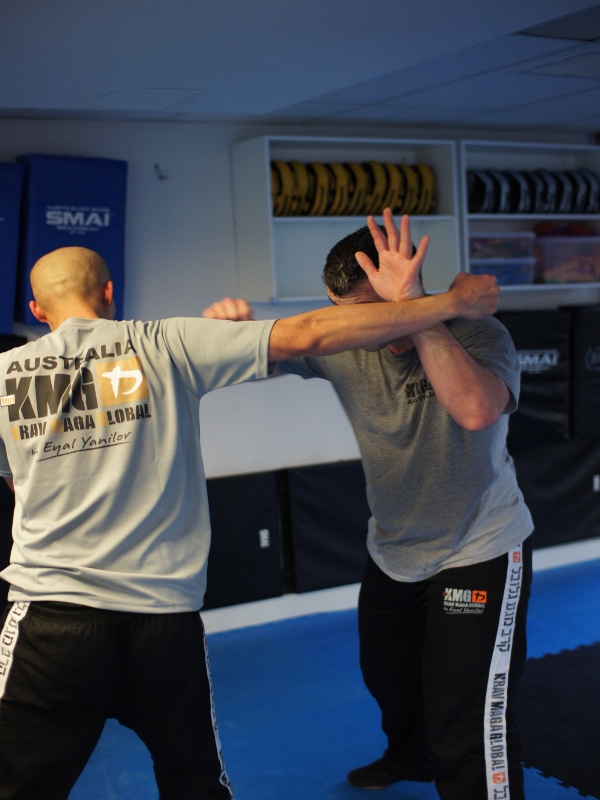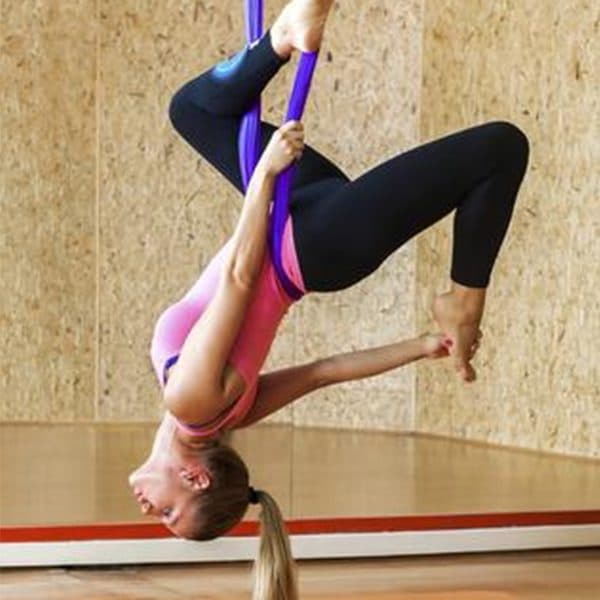
INTRO:
I have spent a good portion of my life training in self defence and have worked very diligently in honing my skills in self defence in the most efficient way possible. This is what drew me to Krav Maga many years ago–its efficiency. In the realm of knife attack defence, it has become evident that a well-rounded approach goes beyond one emphasis on the double control technique.
Through my years of training I’ve been asked this point many times; should I go straight to double control?
This has become the go-to knife defence technique by default by many practitioners of Krav Maga. This essay will examine the importance of integrating simultaneous defence and counter strikes into one’s training. By expanding our knowledge and embracing a broader range of strategies, we empower ourselves to handle real-world threats with greater efficiency and confidence. Throughout this discourse, we will delve deep into the reasoning behind this argument, exploring the practical applications and advantages of incorporating simultaneous attacks in our knife defence repertoire.
It is crucial to recognize that both the double control technique and simultaneous defence with counter strikes hold their unique merits and drawbacks, with their effectiveness contingent upon various situational factors and the individual practitioner’s disposition. In this essay I will examine these techniques, unravel their nuances, and cultivate a comprehensive understanding of their implementation in the overhand stab, or “ice picker” attack.
About Knife Attacks:
Knife attacks present a grave threat due to their potential for severe injury. There are many types of knife attacks, but we’re going to focus on two types of knife attacks: the overhand stab, known as the “ice picker” attack, and underhand knife attacks targeting the stomach region. The overhand stab involves a forceful downward thrust aimed at vital areas, requiring swift action from defenders. Underhand attacks, on the other hand, rely on surprise and proximity, demanding quick and effective defence. Done correctly the underhand is more powerful due to the use of the very large muscles of the back, legs, and buttocks. Each attack type carries distinct risks, necessitating evasion or close-quarters defence. To effectively combat these threats, it is essential to understand the mechanics of these attacks. In the following sections, we will explore the importance of incorporating the double control technique and simultaneous defence with counter strikes, considering their advantages, situational applicability, and effectiveness in real-world scenarios.
Simultaneous Defense & Counter Advantage #1: Solve the Problem Immediately
The simultaneous attack and counter strategy in knife attack defence presents a distinct and powerful approach that sets it apart from the double control technique. One of its noteworthy advantages is the capability to swiftly resolve the threat, capitalising on the element of surprise. When the defender assumes an assertive and aggressive posture and action, it catches the enemy completely off guard, leaving them unable to anticipate the defensive counterattack. The element of surprise disrupts the enemy’s expectations, as they do not anticipate their intended victim to assume the role of the aggressor. Krav Maga is a military system, this is what it is designed for; to eliminate the threat immediately, as fast as possible, and to step forward and strike.
Psychological Advantage
The sudden reversal of roles and unexpected assertiveness also can also have a profound psychological impact on the enemy, causing them to lose their composure and placing them at a disadvantage. This psychological shift from a victim mindset to that of an enemy is pivotal, empowering the defender to take charge of the encounter, the prey now becoming the hunter.
By embracing an offensive mentality, the defender seizes control of the situation, dictating the course of action and effectively neutralising the immediate threat. This proactive approach not only disarms the assailant figuratively but also has the potential to disarm them literally, as a forceful block or counterattack can disrupt their grip on the weapon. The psychological advantage gained through this assertive approach can significantly influence the outcome of the encounter, increasing their chances of successfully defending themselves and destroying the aggressor’s abilities to continue.
Mindset:
Having an aggressive mindset when delivering a strike during the simultaneous counter and attack is vital in being able to deliver a significant blow. Striking with bad intentions that is targeted at a vital point of your enemy could quite possibly damage their CPU and deter them from their attack completely. One could even argue, if your strike is aggressive enough, you wouldn’t even have to worry about blocking.
Advantage #2: Creates Distance
This technique can also create distance. In creating distance, providing the defender with a range of options to effectively neutralise the threat. By executing a swift and aggressive counterattack, the defender gains valuable space and separation from the assailant. This increased distance opens up several opportunities for the defender, enhancing their ability to navigate the situation strategically.
Chance for escape
Firstly, creating distance allows for a greater chance of escape. By putting physical space between themselves and the aggressor, the defender gains valuable time and mobility to disengage from the confrontation entirely. This can be especially crucial in situations where the defender is outnumbered or facing an armed assailant. The ability to retreat to safety and seek assistance becomes more feasible when distance is established.
Chance to use a common object as weapon to distract or barrier
Additionally, the created distance provides the defender with the opportunity to access common objects or improvised weapons in the environment, or manoeuvre one’s self behind a barrier for protection and buy time to negotiate. When faced with a life-threatening situation, utilising nearby objects or barriers as defensive tools can significantly enhance the defender’s chances of success. The increased distance allows for quick assessment and utilisation of potential weapons, such as a chair, bottle, or any other object that can be used for defence or as a deterrent/ tool to strike– these weapons can be used as projectiles. Having a weapon will also completely change the atmosphere of the situation and change the psychology of the enemy as well.
The opportunity to launch a powerful strike and potentially KO opponent
The distance the simultaneous attack and counter technique creates can also enable the defender to deliver powerful and precise strikes to critical points such as the chin, throat, or groyne. This increases the chances of incapacitating the assailant and ending the threat decisively. By leveraging the element of surprise and utilising full leverage in their strikes, the defender gains a tactical advantage, especially against aggressive enemies. Targeting vulnerable areas allows the defender to neutralise the assailant’s ability to continue the attack, significantly enhancing their effectiveness in self-defence situations.
Law enforcement or security
Furthermore, for individuals in law enforcement or security roles, creating distance through the simultaneous attack and counter strategy provides crucial space and time to access their own weapons. Whether it’s drawing a firearm, baton, or other defensive equipment, the increased distance allows for a safer and more controlled transition to deploying their professional tools. This can be vital in situations where lethal force may be necessary or in complying with regulations and protocols that dictate the use of specific tools.
Advantage #3: Chance of disarming
Disarming your enemy is another advantage the simultaneous attack and counter technique can produce, and it can happen during the block or the strike. By launching a forceful and decisive counterstrike while defending against a knife attack, the defender has the potential to create a momentary disruption and instability in the enemy’s grip on the weapon. The swift and aggressive nature of the counterstrike can cause the enemy to momentarily lose control or loosen their grip on the knife, providing the defender with an opportunity to disarm them and gain control of the weapon. This advantage arises from the combination of defensive manoeuvres and offensive actions, as the counterstrike serves not only as a defensive measure but also as a means to seize control of the weapon. By effectively executing the simultaneous attack and counter technique, the defender enhances their chances of disarming the enemy, thereby significantly reducing the potential for further harm or injury. It is important for Krav Maga practitioners to hone their striking precision, timing, and coordination to maximise the advantage of disarming the assailant through this technique.
Advantage #4: Transition into Double Control
Aside from all these advantages, the simultaneous attack and counter technique also provides a seamless transition into the double control technique if necessary. By launching a proactive counterattack, the defender creates an opening to gain control over the assailant’s limbs and weapon. In the event that the initial strike does not incapacitate the enemy, the defender can swiftly adapt and transition into the double control technique to establish physical control and further neutralise the threat. This flexibility allows the defender to seamlessly alternate between offensive strikes and defensive grappling, enabling them to effectively respond to evolving situations during a knife attack encounter.
Summary:
In summary, the simultaneous attack and counter strategy offers advantages such as immediate problem-solving, surprise factor, psychological empowerment, potential for disarmament, creation of distance, and the ability to deliver powerful strikes. However, it requires a specific mindset, initiative, confidence, striking ability, coordination, accuracy, and composure.
Recognizing these advantages and disadvantages allows practitioners to assess the suitability of the technique within their skill set and adapt it to varying self-defence scenarios. Something to note is that the 360 defence could pose an issue; if the defender’s arms are too extended it could cause the enemy’s arm to slide down the defender’s arm and potentially cause injury by the knife making contact.
Disadvantage #1: Action Under Pressure
The simultaneous attack and counter strategy has some disadvantages. It requires a deliberate shift from natural responses, particularly under high-pressure situations. Initiating and maintaining an offensive mindset demands a certain degree of initiative and confidence on the part of the defender. Additionally, having a great deal of coordination is essential, as the simultaneous attack and counter technique requires the defender to block and strike under pressure, which would be difficult for beginners. Under high stress there is the dependency of bisymmetrical actions
Disadvantage #2: Missing your Counter
One notable disadvantage of the simultaneous attack and counter technique is the risk of missing your strike during the counterattack, which requires high-level striking abilities.
Executing an effective and accurate strike demands precise timing, coordination, and proficiency in striking techniques. Without the necessary skill and practice, there is an increased likelihood of failing to land the intended strike, diminishing the effectiveness of the counterattack.
Agitating the Enemy
Missing the strike has the danger of agitating the enemy and potentially angering them further. By launching an aggressive counterattack, there is a possibility of fueling the enemy’s aggression and making them more dangerous. Anger-driven escalation could result in a heightened level of violence, posing a greater risk to the defender. It is essential for practitioners to carefully assess the situation and consider the potential consequences before engaging in a simultaneous attack and counter strategy.
Disadvantage #3: Need High Skills in Striking
Along with coordination, the simultaneous attack and counter technique requires a high base level of striking skill. Executing a significant strike on target while under pressure and in the midst of a counter manoeuvre demands exceptional balance, accuracy, and a considerable amount of striking proficiency. It is essential to maintain control and composure during such intense moments, as any loss of accuracy or balance can diminish the effectiveness of the counterattack and potentially put the defender at a disadvantage. Developing and honing striking skills through consistent training and practice is crucial for maximising the potential of the simultaneous attack and counter technique.
Disadvantage #4: Risk of Injury
Furthermore, there is a risk of injury if the defender lacks coordination and fails to effectively neutralise the live weapon. The proximity to the knife during the execution of the technique necessitates precision and composure to deliver a successful counterattack after defending. Accuracy in striking becomes crucial, as any missed or ineffective blows may expose the defender to further danger. Choosing the suitable technique (type of strike) is essential as well; straight, hook, hammer, elbows, kicks, knees, etc.
Double Control Advantages Intro:
The double control technique, widely taught in self-defence instruction, offers distinct advantages and disadvantages when it comes to knife attack defence. One of its primary advantages lies in the use of both hands to control a limb, providing a practical means to establish control over the enemy. By immobilising the limb holding the knife, the double control technique effectively transforms a live weapon into a static one, minimising the immediate threat. Furthermore, this technique proves particularly valuable in confined spaces where evasion may be limited, as it allows for close-quarter engagement and control.
Advantage #1: Negotiation/De-Escalation
The double control technique provides a significant advantage in de-escalation. By gaining physical control over the enemy’s limb, the defender establishes temporary dominance, creating an opportunity for dialogue and negotiation. This crucial moment allows for the exploration of peaceful resolutions, minimising the need for further violence and ensuring the safety of all parties involved. Proper training in grappling techniques and effective communication skills are vital for maximising the potential of de-escalation in a knife attack encounter. As Krav Maga practitioners, we must emphasise the importance of incorporating de-escalation techniques alongside physical self-defence training to promote a safer and more effective approach to personal safety.
Advantage #2: Live Weapon into a Static Weapon
This technique also has the ability to transform a live weapon into a static weapon, thereby mitigating the potential harm posed by the enemy. When the defender successfully gains control over the assailant’s limb, their ability to wield the weapon effectively is greatly diminished. By
restricting the enemy’s movements and limiting their range of motion, the defender minimises the risk of injury and significantly reduces the enemy’s capacity to deliver powerful strikes. This transformation from a live weapon to a static weapon grants the defender a heightened sense of safety and allows for more deliberate and strategic decision-making in their response. However, it is crucial to highlight that attaining this advantage necessitates a combination of skill, technique, and control, underscoring the vital role of comprehensive training in the double control technique. As dedicated Krav Maga practitioners, we embrace this advantage, recognizing its paramount importance in fortifying our self-defence capabilities and empowering us to protect ourselves and others effectively.
Advantage #3: Good in Confined Spaces
The double control technique is highly effective in confined spaces. In situations where escape or creating distance is limited, such as narrow hallways or crowded environments, this technique provides a practical solution for defending against a knife attack. By gaining control of the assailant’s limb, the defender can effectively manage proximity, restrict the enemy’s range of motion, and minimise the risk of harm to bystanders. However, executing the technique in confined spaces requires adaptability and awareness of the environment. As Krav Maga practitioners, we value the advantage of the double control technique in these situations, emphasising the importance of training to develop the necessary skills for effective self-defence.
Advantage #4: Smaller Frames
Another notable advantage of the double control technique, particularly for individuals with smaller frames or women, is its suitability for leveraging body mechanics and maximising control. When facing a larger and potentially stronger assailant, the use of two hands to control one of their limbs can compensate for any disparity in physical strength. This technique allows the defender to utilise their entire body, employing leverage and positioning to neutralise the enemy’s strength advantage. By distributing the force exerted on the assailant’s limb across both hands, the defender can effectively maintain control and restrict their movements.
Furthermore, the double control technique enhances the defender’s stability and balance, minimising the risk of being overpowered or easily dislodged by a larger opponent. This advantage makes the double control technique an invaluable tool for individuals with smaller frames, enabling them to assert control and defend themselves effectively even against physically imposing adversaries.
Disadvantage #1: Limited Offensive Options
However, the double control technique does come with its share of disadvantages as well. One significant limitation is the restriction it places on the defender’s offensive capabilities. With both hands engaged in controlling the enemy’s limb, options for counterattacks are limited, often reducing the defender to using knee strikes or headbutts as primary offensive measures. This restriction diminishes the versatility and range of available responses, making it critical for the defender to compensate for the limited offensive options.
Disadvantage #2: Requires High Level Grappling
Moreover, executing the double control technique effectively requires a high level of grappling skills and expertise. Mastery of various grappling techniques, such as joint locks, holds, and leverage principles, is necessary to establish and maintain control over the enemy throughout the encounter. Without sufficient proficiency in these techniques, the defender may struggle to immobilise the assailant effectively, potentially jeopardising their own safety and increasing the risk of injury. It is crucial for Krav Maga practitioners to invest time and effort in developing their grappling skills through consistent training, drilling, and sparring sessions to ensure the successful execution of the double control technique in real-world scenarios. By honing their grappling abilities, practitioners can confidently neutralise and control the enemy, maximising the effectiveness of the technique in their self-defence repertoire.
Disadvantage #3: Physical Strength & Size Requirement
The double control technique does have its advantages when you are smaller, but only to a certain degree. If your enemy is significantly larger, it can pose challenges for individuals with smaller frames, including women, due to potential large size and strength disadvantages.
However, by developing technical proficiency, leveraging agility and speed, and utilising strategic positioning, smaller individuals can overcome these challenges and effectively implement the double control technique. Size should not be seen as a limiting factor in
self-defence, but rather an aspect that can be compensated for through skill, adaptability, and resourcefulness. However, if the size and strength advantage of the enemy is too great, there are limits to what the defender can actually do.
Disadvantage #4: Limited Escape Options
Additionally, the limited options for escape present a potential drawback of the double control technique. While it offers the advantage of control over the enemy, it inherently limits the defender’s mobility and ability to disengage swiftly from the encounter. Once the double control is established, the defender’s focus shifts towards maintaining control and neutralising the immediate threat, which can restrict their movement and flexibility. In situations where the situation escalates or multiple enemies are involved, the defender may find themselves locked in a grappling exchange, potentially limiting their ability to assess the evolving threat landscape or effectively respond to additional assailants. It is crucial for Krav Maga practitioners to be cognizant of this limitation and train accordingly, developing alternative strategies and contingency plans for scenarios where escape becomes the primary objective. By incorporating a holistic approach to self-defence training, including situational awareness, strategic positioning, and multiple defensive options, practitioners can mitigate the disadvantages associated with limited escape opportunities in double control scenarios.
Conclusion:
In conclusion, it is important to recognize that each self-defence technique has its own set of advantages and limitations. The choice of technique should be based on the specific situation, the physical attributes of the defender, and their level of self-defence training. While different approaches may be appropriate in certain circumstances, utilising the simultaneous attack and counter technique as the first option offers numerous advantages. This technique provides a range of defence opportunities, including the ability to create space, neutralise the threat with a well-placed strike, utilise common objects as weapons or barriers, and create an opportunity for escape. These prevention measures help to maintain distance and avoid engaging the enemy in close proximity, as would occur with double control. Moreover, starting with the simultaneous attack and counter technique allows for a smooth transition into double control if necessary.
Adopting a default approach of going straight into double control may limit options and overlook the diverse opportunities presented by the simultaneous attack and counter technique. Thus, considering the advantages it offers, the simultaneous attack and counter should be prioritised as the initial option in self-defence situations.



